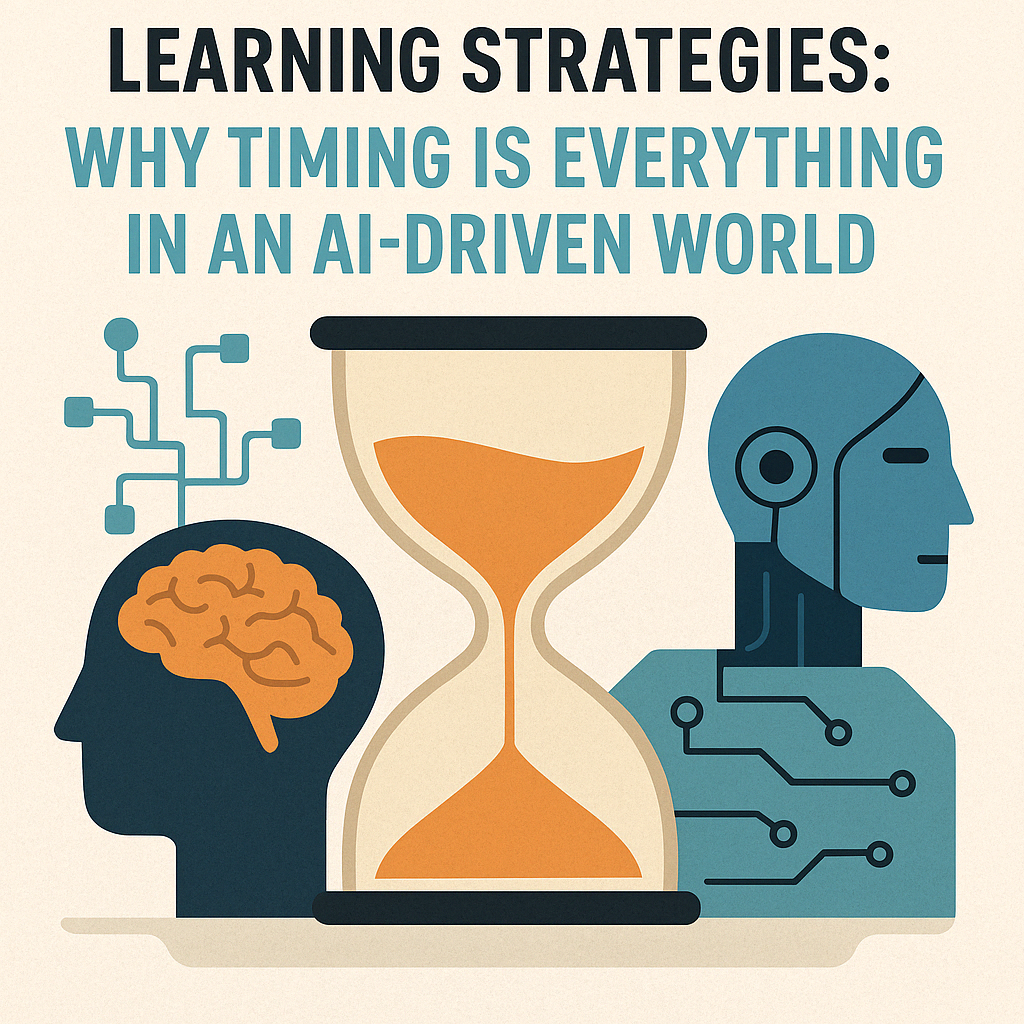From “nice to have” to “absolutely critical”
Learning strategies are a very abstract topic – something you realise when you’re the founder of a content-independent learning strategy platform, trying to explain your product. So, let’s put some real “meat on the bones” — in a vegetarian way! If learning strategies were a vegetable, they’d be spinach: essential, packed with benefits — and still overlooked far too often.
Today, when AI can write essays faster than students can open a textbook, learning strategies have shifted from “nice to have” to “absolutely critical.” Knowing how to learn is the key skill that will separate thriving students from those struggling to keep up.
The two urgent questions
But two urgent questions remain:
- When should learning strategies be taught?
- And who should be responsible for teaching them?
In this article, we explore why early primary years are too soon, why secondary school is too late, and why the window between 9 and 12 years offers the best opportunity. We’ll also show how enduri provides the structure, strategies, and tools students need to succeed in a world where content is infinite but focus is rare.

Learning strategies have shifted from “nice to have” to “absolutely critical.” Knowing how to learn is the key skill that separates thriving students from those struggling to keep up.
Why Learning Strategies Matter More Than Ever (With AI)
Learning skills vs. content overload
In the era of AI, students no longer lack access to information. Instead, they face the opposite problem: too much information and too few tools to manage it. Without strategies like planning, active recall, and metacognitive reflection, students risk becoming passive recipients of AI-generated answers rather than active thinkers and learners [1].
The new role of learning strategies
Learning strategies help students:
- Navigate content overload.
- Retain and apply knowledge meaningfully (meaning: understand it, not just copy-paste it).
- Stay motivated and independent in their learning process — not being passengers, but becoming independent explorers.
Without learning strategies, the risk isn’t just falling behind — it’s becoming irrelevant.
Early Primary Years: Why It’s Too Soon
Focus: Literacy, numeracy, social development
In the early years (ages 4–8 depending on the school system), students’ cognitive focus is on:
- Basic literacy (reading and writing).
- Numeracy (basic math operations).
- Social competencies (listening, cooperating, emotional regulation).
Research shows that strong reading skills are the foundation for all future learning [2]. If learning strategies are spinach, reading is the soil — without it, nothing grows properly.
Introducing complex learning strategies too early risks overwhelming young learners before they have mastered the basics.
Studies confirm: Build the foundation first
Neuroscience and education studies recommend that early primary education should concentrate on foundational academic and socio-emotional skills before introducing abstract learning strategies [3]. In short: First learn to read, count, listen, and cooperate — then start worrying about learning to learn.
Secondary School: Why It’s Too Late
Pressure, hormones, and disengagement
By the time students reach secondary school (ages 11+), several barriers have emerged:
- High academic and social pressure.
- A new, bigger school system with older students.
- Heavy peer influence and social distractions.
- Skyrocketing screen time (UK teens average 6–7 hours of screen time daily [4]).
- Decreased receptiveness to being taught “how to learn.”
Teachers often assume students know how to learn simply because they’ve spent years in the system — spoiler alert: they don’t.
Research shows: Timing matters
Psychological studies show that adolescents under high stress are less likely to adopt new cognitive strategies [5]. Habits (good or bad) are already deeply ingrained by this point, making it far harder to introduce lasting change.
The Golden Window: Ages 9–12
Why 9–12 is ideal
Between the ages of 9 and 12, students are:
- Competent readers and writers.
- Capable of abstract thinking.
- Open to learning new techniques.
- Still relatively free from overwhelming academic and social pressures.
- Still enthusiastic about school — a Stanford study shows motivation and school enjoyment start to drop sharply around age 12 [6].
- At a brain development stage where purpose, meaning, and reflection begin to matter.
This is the golden window: a rare, perfect blend of readiness, flexibility, and curiosity.
The Golden Window: A Rare Mix of Readiness, Flexibility, and Curiosity
But what does learning actually look like for students within this “golden window”? Two short examples:
Jana (11) is struggling with a chaotic learning environment: her desk is buried under books, comic booklets, empty chip bags, sweaty gym clothes, and a constantly buzzing phone.
In the middle of it all, she’s trying to focus on a half-finished worksheet while YouTube music videos play in the background.
With enduri’s “Get-Ready Tips”, Jana learns to:
• tidy up her workspace and set it up in a way that suits her needs so she can concentrate better,
• hang a “Do Not Disturb” sign on the door and actively ask her environment for support,
• remove distractions like her phone and tablet completely from the room (NO — not just turned over or pushed aside!), and avoid extra noise sources like music,
• consciously reflect on her learning process.
Leon (10) reads fluently but has trouble organizing information in a structured way and placing it in the right text context.
With enduri’s visual learning strategies, Leon learns to:
• create a timeline,
• design the timeline in a way that plays to his strengths — drawings, color-coding, and sketches bring structure and clarity,
• adapt the strategy to his individual needs, for example by adding movement, auditory cues, or visual inputs,
• consciously reflect on his learning process.
Why enduri Focuses on the 9–12-Year-Olds
It’s about mindset, not academic level
At enduri, we believe that learning strategies are not about academic achievement — they’re about building the capacity to learn independently across subjects and stages of life.
We focus on the 9–12 age group because:
- Cognitive readiness to reflect and adapt is high.
- Openness to new methods is strong before academic and social pressures escalate.
- Positive habits can still be shaped without dismantling years of bad ones.
It’s about the learning process, not the test results
Through strategies like:
- Planning: Offering a range of needs-based planning strategies, like creating realistic to-do lists and setting up simple homework planning tools to stay on top of deadlines without stress.
- Organising: Helping students set up both physical and digital learning spaces that are tidy, calm, and distraction-free.
- Prioritising: Teaching how to break down tasks, identify what’s urgent versus important, and focus energy where it matters most.
- Memorising: Using active recall techniques, flashcards, mnemonics, visual aids like mind maps, and colour-coded timelines to make learning stick.
- Reflecting: Encouraging students to evaluate which strategies work best for them and adapt their learning habits over time.
Conclusion: The Right Time Is Before the Race Starts
Learning strategies as the learning foundation
Teaching learning strategies isn’t something to “add later” once students start to struggle.
It’s the foundation they need before the real academic marathon even begins.
The best time? When students are still curious, flexible, and open to shaping how they learn — between 9 and 12 years.
enduri as the perfect tool
The best tool? enduri — the first platform designed to equip students with individualised learning strategies, supporting both learners and teachers for the long run.
Because at the end of the day, learning strategies are like spinach:
You might not notice their magic immediately – but without them, you’ll run out of strength long before you reach the finish line. Discover more at www.enduri.org
Sources:
1. Dunlosky, J. (2013).
Strengthening the Student Toolbox: Study Strategies to Boost Learning
→ American Educator, Fall 2013, Vol. 37, No. 3, pp. 12–21.
2. Snow, C. E. (2002).
Reading for Understanding: Toward an R&D Program in Reading Comprehension
→ RAND Corporation.
3. Blair, C., & Raver, C. C. (2015).
School Readiness and Self-Regulation: A Developmental Psychobiological Approach
→ Annual Review of Psychology, 66, 711–731.
4. Ofcom (2023).
Children and Parents: Media Use and Attitudes Report 2023
→ Ofcom official website.
5. Putwain, D. W. (2007).
Test Anxiety in UK Schoolchildren: Prevalence and Demographic Patterns
→ British Journal of Educational Psychology, 77(3), 579–593.
6. Steinberg, L. (2014).
Age of Opportunity: Lessons from the New Science of Adolescence
→ Houghton Mifflin Harcourt.

